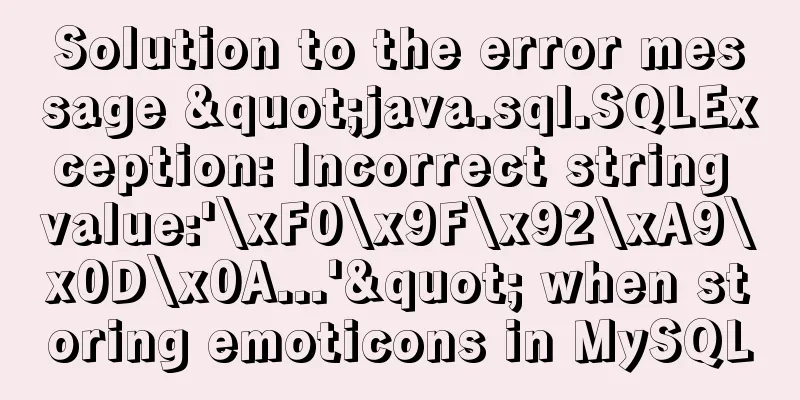Introduction to JavaScript strict mode use strict

1. Overview 1.1 What is strict mode? Strict mode is a more restrictive variant of Although most browsers now support strict mode, some older versions of browsers still do not support strict mode, so do not use strict mode without testing the strict mode features. Strict mode and non-strict mode can coexist in 1.2 Purpose of strict modeThe purpose of using strict mode is as follows: First, strict mode turns 2. Enable strict mode There are two ways to enable strict mode in 2.1 Enable strict mode globallyTo enable global strict mode, you only need to enter a string before all the codes. The string is as follows: "use strict"; // or 'use strict'; It should be noted that if the previous 2.2 Locally enable strict mode To enable strict mode locally, you can add the string " The example code for enabling strict mode is as follows:
//Globally enable strict mode //"use strict"
v = 100
console.log(v)
function fun() {
// Locally enable strict mode 'use strict'
vv = 200
console.log(vv)
}
// fun() throws an exception vv is not defined
3. Variables in strict mode 3.1 Prevent accidental creation of variablesThe so-called accidentally created variables are variables declared without using the var keyword. When in strict mode, if a global variable is accidentally created, an exception will be thrown. The sample code is as follows: 'use strict' // In non-strict mode, creating a variable like this will not report an error, but in strict mode, creating a variable like this will throw an exception v = 100 console.log(v) 3.2 Silent failure turns into exceptionSilent failure means no error and no effect. In strict mode, it will be turned into an exception. 3.3 Disable the delete keywordIn non-strict mode, using the delete keyword on a global variable will fail silently, while in strict mode, an exception will be thrown. The sample code is as follows 'use strict' var v = 100 delete v // SyntaxError: Deleteofanunqualifiedidentifierinstrictmode. console.log(v) 3.4 Restrictions on variable names In strict mode, 4. Objects in strict mode 4.1 Non-deletable attributes In non-strict mode, using the The sample code is as follows: "use strict" delete Object.prototype; //Throw an exception 4.2 Assignment of read-only propertiesIn non-strict mode, assigning a value to a read-only property will fail silently, but in strict mode an exception will be thrown. The sample code is as follows:
'use strict'
var obj = {}
Object.defineProperty(obj, 'name', {
value: 'a bowl of porridge',
})
obj.name = 'Yiwan Zhou' //Throws an exception 4.3 Non-extensible objectsAdding new properties to a non-extensible object will fail silently in non-strict mode, but will throw an exception in strict mode. The sample code is as follows:
// Enable global strict mode 'use strict'
var obj = {}
//Make it non-extensible Object.preventExtensions(obj)
//Extend the object attribute obj.name = 'Yiwan Zhou' //Throw an exception 5. Functions in strict mode 5.1 Parameter names must be uniqueIn non-strict mode, function parameters can be repeated, but in strict mode, if the function parameters are repeated, an exception will be thrown. The sample code is as follows:
'use strict'
function fun(a, a, b) {
console.log(a + a + b)
}
/*
*The result in non-strict mode is 7=2+2+3
*An exception will be thrown in strict mode*/
fun(1, 2, 3)
5.2 Differences in arguments The differences are as follows:
The sample code is as follows:
'use strict'
function fun(v) {
v = '100'
console.log(v)
console.log(arguments[0])
}
/*
* The result printed in non-strict mode is 100, 100
*The results printed in strict mode are 100, 200
*/
fun(200)
5.3 arguments.callee property In non-strict mode, you can use the The sample code is as follows:
'use strict'
function fun(){
console.log(arguments.callee);
}
fun()//Throw an exception 5.4 Restrictions on Function DeclarationsIn strict mode, functions can only be declared in the global scope and local scope. It is an error to declare function syntax outside of these two scopes (such as if statement blocks). The sample code is as follows:
'use strict'
function fun() {
console.log(arguments.callee)
}
fun() //Throw an exception 6. Increase the scope of eval() In strict mode, variables created with the An exception will be thrown when used externally. The sample code is as follows:
'use strict'
eval('var v=100')
console.log(v) //Throw an exception 7. Suppress this When using the The sample code is as follows:
// Enable strict mode 'use strict'
var v = 100
function fn() {
console.log(this.v)
}
var obj = {
v: 200,
}
fn.call(obj) //this points to the global object Conclusion: This article basically introduces all the situations of strict mode, which is sufficient to solve the problems related to strict mode in daily development. This is the end of this article about You may also be interested in:
|
<<: Summary of the dockerfile-maven-plugin usage guide
>>: Pure CSS to adjust Div height according to adaptive width (percentage)
Recommend
CSS shadow animation optimization tips
This technique comes from this article - How to a...
Example code for implementing random roll caller in html
After this roll call device starts calling the ro...
Recommend several MySQL related tools
Preface: With the continuous development of Inter...
How to install and deploy MySQL 8.0 under CentOS8
MySQL 8 official version 8.0.11 has been released...
Example of deploying Laravel application with Docker
The PHP base image used in this article is: php:7...
Demystifying the HTML 5 Working Draft
The World Wide Web Consortium (W3C) has released a...
More elegant processing of dates in JavaScript based on Day.js
Table of contents Why use day.js Moment.js Day.js...
Explanation of MySQL performance inspection through show processlist command
The show processlist command is very useful. Some...
Detailed tutorial on installing Anaconda3 on Ubuntu 18.04
Anaconda refers to an open source Python distribu...
Are you still Select *?
There are many reasons why an application is as s...
How to implement HTML Table blank cell completion
When I first taught myself web development, there...
Steps to export the fields and related attributes of MySQL tables
Need to export the fields and properties of the t...
Detailed explanation of for loop and double for loop in JavaScript
for loop The for loop loops through the elements ...
How to use squid to build a proxy server for http and https
When we introduced nginx, we also used nginx to s...
How to customize Docker images using Dockerfile
Customizing images using Dockerfile Image customi...









